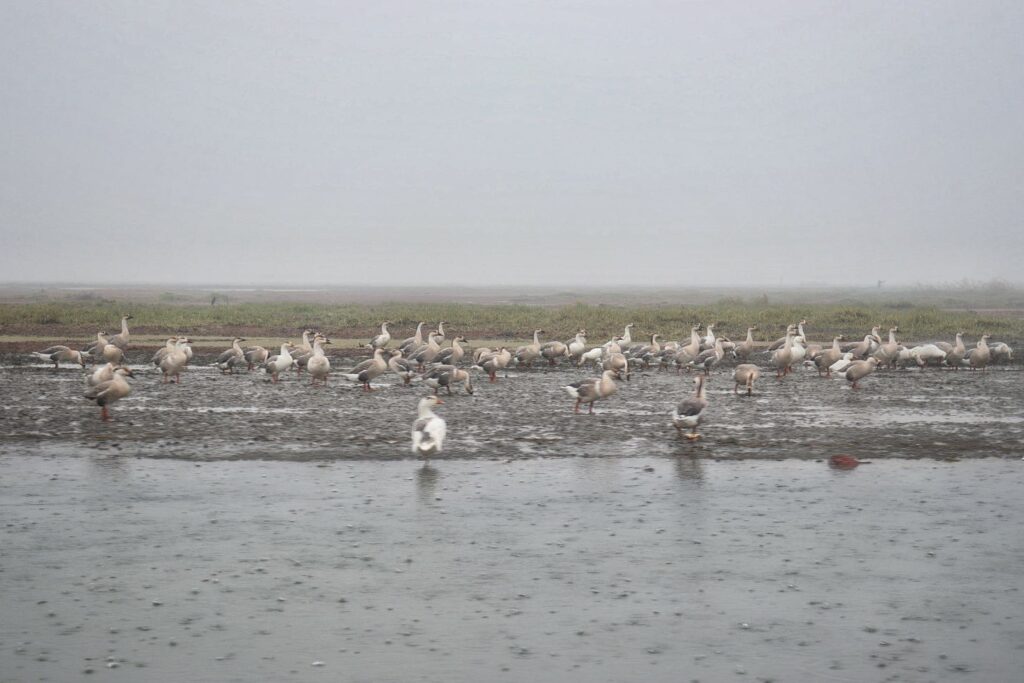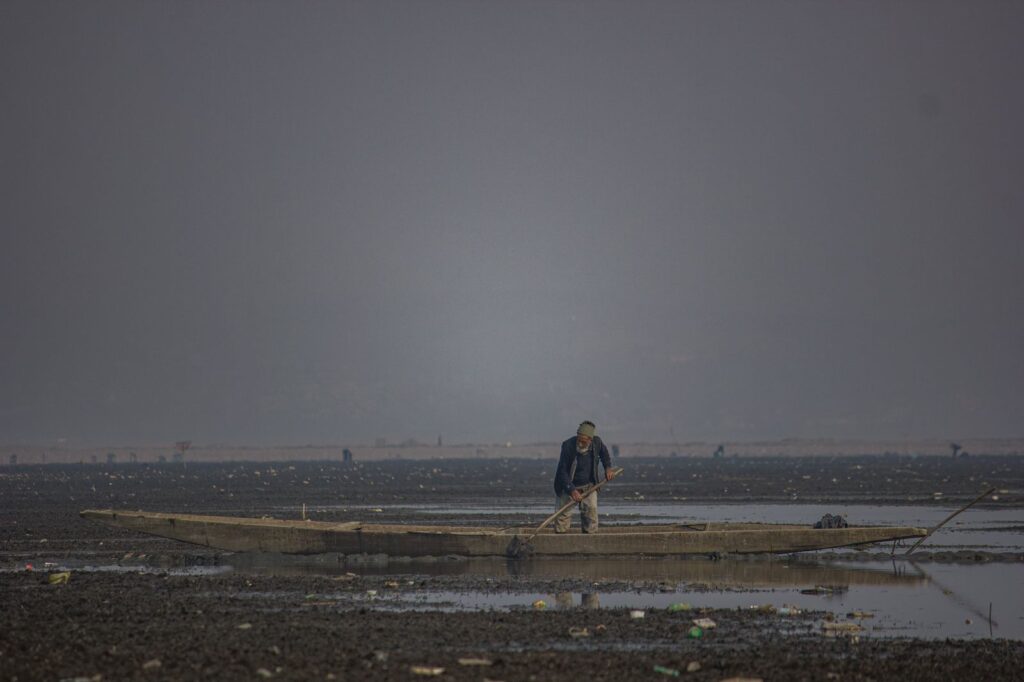Wular lake, Asia’s largest fresh water lake wears a festive look with the onset of the winter in Kashmir, specifically in December. Despite the bone chilling cold and unpredictable weather, particularly during the 40-day harsh period known as ‘Chillai Kalan’, the boatmen, in order to make a living, continue to brave the conditions to harvest water chestnuts, locally knows as ‘Gaer’.

Originating in mainland Asia and mainly cultivated in countries like India, China, Pakistan and Thailand, water chestnuts are commonly referred as ‘Singhara’ in Hindi/Urdu and ‘Gaer’ in Kashmiri. With a slightly sweet taste, water chestnuts have a crisp and crunchy texture. Wrapped in spiky shelled covers, they are more like corms that grow under water in ponds, shallow lakes, and marshy lands.
Water chestnuts grow naturally and not require fertilizers or other supplements to thrive. In October, as autumn approaches the raw chestnuts detach and descend to the riverbed. The spike shell covered kernels then absorb plenty of water, marking the beginning of the ripening process.
Since ancient times, atleast 30 lakeshore villages from Banyari to Laharwapora, have been associated with the extraction of water chestnuts from the river, with more than 80% of their population participating in it.

The Voices took a boat from Banyari, the southern end of the lake, where the Jhelum renters Wular. As the boat traversed the waters the depth and swampiness of the lake was evident. After two and half hours one could find the boatmen associated with the water chestnut extraction. It was raining heavily, and the fog had engulfed most part of the lake making it impossible for the boatmen to work.
In the past, these boatmen used to embark on their journey early in the morning, returning with boats laden with chestnuts late in the evening. However, the customs have evolved, with the boatmen now spending a week in the expansive Wular and returning home on Fridays with chestnuts on board. The unique tool ‘Kum Khurr,’ which plays a vital role in the extraction, has led to these specific boatmen being referred to as “Kum Haenz” by the locals.

The chestnut extracting boatmen have adapted their work schedule by creating dwelling spaces known as ‘douks’ from ordinary boats that are typically used for collecting sand from the river. These boats have undergone modifications, with one-third of the boat now covered in tarpaulin. The rear section of the boat is reserved for storing firewood and other essentials. The middle section serves as the bedroom, while the undercover area towards the periphery is designated as the kitchen. Despite the challenges involved, these boatmen endure the hardships of this process to provide for their families.

“With peak season being in the harsh winters the frozen lake leaves these men stationed at a single place in the middle of nowhere and inviting a threat of suffering cold cracks, hypothermia and mental instability”, says Dar.
Oldest among the boatmen is septuagenarian Mohammad Jamal Dar. Energetic and experienced, he works hand in hand with his fellow boatmen who are in their forties. Jamal, who has dedicated almost four decades to this work, considers Wular his second home. He is quick to criticize the policies of successive governments and the projects that have displaced them eight kilometers away from the periphery, where they used to extract chestnuts in the past.
“We wouldn’t have been subjected to work under the harsh circumstances if the authorities wouldn’t have pushed us offshore”, says Jamal while sipping the hot Nunchai(salt tea). Despite having a family of eight to feed, Jamal has made the decision to not involve his elder son in the chestnut extraction work. He recognizes that the work is underpaid and entails a significant struggle and hard work.
The Wular provides a majestic view with mountains all around, the boats appear like spaceships traversing the galaxies. It’s chillai kalan and the sun is struggling to come out so are the boatmen.

In the living room of the boat, The Voices notices that Jamal is feeling worried about the potential damage to the boat due to incessant rains and snow. “Whenever there is precipitation, we have to remain awake during the nights to ensure that boats don’t get damaged and capsized”, say Jamal.
The navigation
The chestnut extracting boatmen do not have any specific navigation devices on their boats. Instead, they rely on old-style keypad phones that do not have GPS capabilities. These phones are primarily used to contact their families once a day. To conserve battery life, the boatmen keep their phones switched off most of the time. By doing so, they can ensure that the battery lasts for about a week, allowing them to have conversations with their families without worrying about the battery draining in a single day.
The steady fog engulfing the Wular reduces the visibility, and it becomes quite difficult for the boatmen to traverse through the lake. However, an age-old tradition helps them, as they guess their coordinates with the help of rising sun. Naseer Ahmad Dar, 38, has been associated with the chestnut extraction from last 20 years. He says it is very dangerous to traverse during the fog.

Water chestnuts grow naturally in Wular because of the marshy nature of the lake which compliments its production. The cultivation of the water chestnuts usually happens in three shifts. First shift involves the extraction of ‘Sabz Gaer’/ ‘Sabaz Singhara’ or the raw chestnuts. This lasts from August to September. After that the chestnuts absorb the water and descend to the base and settle there, known as ‘Beh Gaer’ or the ‘dry singhara’. During this phase, the extraction of these chestnuts is not as frequent. ‘Beh Gaer’ with passing of a month or two gets detached from the plant and start floating just below the surface of water. Beh Gaer and Sabz Gaer extraction witness active participation of the women folk however, the production of these chestnuts tends to be lower compared to the fully ripened water chestnuts. When the water chestnuts have fully ripened and acquired a blackish color, they are set for final extraction, referred to as “Abhi Singhara” due to their high water absorption’.

Every day, groups of boatmen in Wular Lake enclose a specific area by using ropes. They then proceed to board smaller boats, where some of them use the “Kum Khurr” to wipe the chestnuts off the lake bed. Meanwhile, their fellow boatmen on another boat collect the impure chestnuts by hand. Once collected, the chestnuts are washed to remove mud and other impurities.
The individual extraction of water chestnuts amounts to approximately 30 kilograms per day, earning a person a sum of around 600-700 rupees. Throughout the week, the harvested chestnuts are stacked and dried. By Thursday evening, the boats laden with chestnuts depart for their respective destinations, which are the homes of the boatmen.

The kernels are then further dried up and sold at reasonable rates across the valley.
According to Dar, the production of water chestnuts has decreased over time. Previously, when the lake was less polluted and encroached upon, individuals could collect up to 50 kilograms each, earning at least 1000 rupees.
“At WUCMA, we are working on developing new marketing strategies by introducing value-added products such as chestnut flour and cookies, which are highly beneficial.” — Mudasir Mehmood

Internal Struggle
Chestnut extraction from Wular Lake is a practice that is open to all, with no ownership involved. However, over time, the boatmen have become increasingly greedy. Mushtaq Ahmad Dar, 42, and his companions have positioned their boats in a way that prevents other boatmen from accessing the other side of the lake, acting as if they own it. Despite Mushtaq’s attempts to involve the authorities, the situation remains unresolved.
In addition to the challenges faced in collecting chestnuts,
the boatmen also lack access to clean drinking water. The water in the lake is contaminated and unsuitable for consumption, leaving the boatmen with no other choice. This lack of clean water is a cause for concern, as it could lead to illness among the boatmen.

Water chestnuts occupy a total of 21.2 square kilometers of lake area, representing 49.8% of the total lake vegetation. The production has been quite exponential during the last five years. According to official records, the production of ‘Sabaz Singhara’ stood at approximately 40,200 quintals, while the production of ‘Dry Singhara’ stood at approximately 7,600 quintals, and the production of ‘Abi Singhara’ stood at approximately 168,125 quintals.
The registered number of beneficiaries for Sabaz and Dry Singhara stood at 2162 and 933, respectively. The registered number of beneficiaries for Abi Singhara stood at 3616.
The Benefits of Water Chestnuts
After harvesting, water chestnuts are shelled and the kernels are dried, a practice mostly done by women to make them crispy and tasty. Water chestnuts are devoid of cholesterol and fat, making them beneficial for diabetes patients.
“At WUCMA, we are trying to develop new marketing strategies by introducing value-added products like chestnut flour and cookies, which are highly helpful,” added Mehmood. However, Mehmood mentioned that the process is still in its infancy, and they hope this will help boost the chestnut industry and attract global attention in the future.

WUCMA and The Boatmen
Extracting chestnuts is nowadays is subjected to the proper registration at the WUCMA. The boatmen have to obtain a four-month license after submitting a fee of rupees 500. These boatmen mostly belong to BPL families. Boatmen claim that before August 2019 they were entitled to some financial support and boat material from the authorities as a process of rehabilitation. However till date neither the remuneration nor the materialistic help has reached them.
However, according to Mudasir Mehmood there is no rehabilitation process for them because they are actively involved in the trade.
After spending more than 4 months in the Wular these boatmen return home. However, their livelihood still depend upon the produce of Wular. Until the next season they will pursue the livelihood through fishing and sand extraction.

